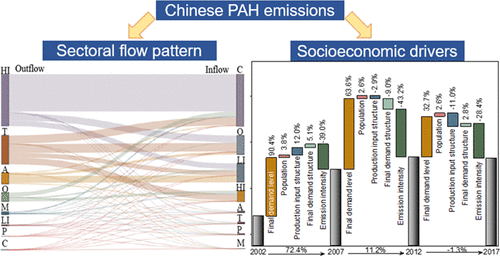当前位置:
X-MOL 学术
›
Environ. Sci. Technol.
›
论文详情
Our official English website, www.x-mol.net, welcomes your feedback! (Note: you will need to create a separate account there.)
Consumption- and Income-Based Sectoral Emissions of Polycyclic Aromatic Hydrocarbons in China from 2002 to 2017
Environmental Science & Technology ( IF 11.4 ) Pub Date : 2021-03-01 , DOI: 10.1021/acs.est.0c08119 Ruifei Li 1 , Jin Zhang 2 , Peter Krebs 1
Environmental Science & Technology ( IF 11.4 ) Pub Date : 2021-03-01 , DOI: 10.1021/acs.est.0c08119 Ruifei Li 1 , Jin Zhang 2 , Peter Krebs 1
Affiliation

|
China is the largest emitter of polycyclic aromatic hydrocarbons (PAHs) in the world. Because of their negative influences on human health, the characteristics and potential driving forces of PAH emissions should be evaluated to establish effective mitigation strategies for different economic sectors. This study is the first to quantify the embodied and enabled PAH emissions of 108 sectors in China in 2002, 2007, 2012, and 2017. The results show that the total sectoral emissions increased by 92% (from 28.0 to 53.7 kt) from 2002 to 2012 and decreased to 53.0 kt in 2017. The eight aggregated sectors had different characteristics according to their production-, consumption-, and income-based emissions. Both the embodied and enabled emission flows increased (from 13.8 to 29.2 kt and from 11.3 to 20.5 kt, respectively) with time. The influences of the major final demands and primary inputs reversed from increasing to decreasing emissions over time. In particular, the primary input structure had a stronger impact on decreasing emissions than the final demand structure. The results revealed that different mitigation policies should be applied to different sectors and that adjusting primary input behaviors might be a relatively efficient method to reduce PAH emissions.
更新日期:2021-03-16


























 京公网安备 11010802027423号
京公网安备 11010802027423号